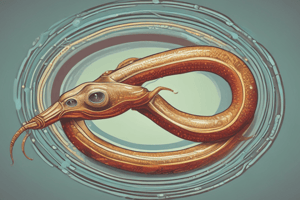Podcast
Questions and Answers
What is the estimated number of deaths caused by schistosomiasis per year?
What is the estimated number of deaths caused by schistosomiasis per year?
- 500,000+
- 200,000+ (correct)
- 300,000+
- 100,000+
What is concomitant immunity, and how does it affect the host and the parasite?
What is concomitant immunity, and how does it affect the host and the parasite?
- The host is completely cured of the parasite, and the parasite is eliminated.
- The host is protected against new infections, but the parasite eliciting the immunity remains alive and unaffected. (correct)
- The host develops a strong immune response, killing all parasites including the adults.
- The host and parasite have no interaction, and the host remains unaffected.
What is the difference between mean intensity and abundance in the context of parasitic infections?
What is the difference between mean intensity and abundance in the context of parasitic infections?
- Mean intensity counts the infected individuals, while abundance counts the total number of parasites.
- Mean intensity divides the total number of parasites by the infected individuals, while abundance divides by the total sample size. (correct)
- Mean intensity counts the total number of parasites, while abundance counts the infected individuals.
- Mean intensity divides the total number of parasites by the total sample size, while abundance divides by the infected individuals.
Why does the host develop an immune response to mansoni, but not to japonicium?
Why does the host develop an immune response to mansoni, but not to japonicium?
What is the number of countries where schistosomiasis transmission has been reported?
What is the number of countries where schistosomiasis transmission has been reported?
Which species of Schistosoma has the highest level of host specificity?
Which species of Schistosoma has the highest level of host specificity?
What is the primary epidemiological factor in the transmission of Schistosoma?
What is the primary epidemiological factor in the transmission of Schistosoma?
Which of the following is a characteristic of the Acute phase of Schistosomiasis?
Which of the following is a characteristic of the Acute phase of Schistosomiasis?
Which species of Schistosoma is found in the portal veins draining the small intestine?
Which species of Schistosoma is found in the portal veins draining the small intestine?
What is the term for the stage of the Schistosoma life cycle where the miracidium goes in and the cercaria goes out?
What is the term for the stage of the Schistosoma life cycle where the miracidium goes in and the cercaria goes out?
Flashcards are hidden until you start studying
Study Notes
Life Cycle of Schistosoma
- Schistosoma Mansoni: inhabits veins that drain the large intestine
- Schistosoma Japonicum: inhabits a vein that drains the small intestine
- Schistosoma Haematobium: inhabits veins that drain the urinary bladder
- Each species infects through skin penetration in water, with miracidium entering and cercaria exiting the snail host
Host Specificity
- Schistosoma Mansoni: moderate host specificity, with reservoir hosts including rodents and monkeys
- Schistosoma Haematobium: highest host specificity, with no known reservoir hosts, and prefers veins of the urinary bladder
- Schistosoma Japonicum: least host-specific, with reservoir hosts including rodents, cats, dogs, pigs, cattle, horses, and deer
Pathology
- Three phases: migratory, acute, and chronic
- Migratory phase: from penetration to reproductive maturity, often with no symptoms or dermatitis reaction
- Acute phase (Katayama fever): occurs when schistosomes begin producing eggs, causing symptoms like chills, fever, fatigue, and more
- Chronic phase: S. Mansoni causes hepatic and pulmonary cirrhosis, hepatosplenomegaly; S. Haematobium causes ulcerated bladder wall and bloody urine; S. Japonicum causes hepatic and pulmonary cirrhosis, hepatosplenomegaly, and cerebral schistosomiasis
Epidemiology
- Human waste water containing an intermediate host is the primary epidemiological factor
- Schistosoma Mansoni: broad distribution in Africa, Middle East, South America, and the Caribbean
- Schistosoma Japonicum: limited to Japan, China, Taiwan, the Philippines, and Southeast Asia
- Schistosoma Haematobium: limited to Africa and adjacent regions
- Schistosomes can live 20-30 years in the body
- Schistosomiasis transmission reported in 78 countries, with 75.3 million people treated in 2021 and 200,000+ deaths per year
Immunity and Transmission
- Concomitant immunity: the host is protected against new infections, but the parasite remains alive and unaffected
- Example: once infected with S. Mansoni, the host develops immunity, but it only affects future S. Mansoni infections, not existing ones
- S. Japonicum can penetrate and infect an individual already infected with S. Mansoni due to concomitant immunity
Studying That Suits You
Use AI to generate personalized quizzes and flashcards to suit your learning preferences.




